- Big Macs
updated
2014
Aug 5

| the
Economic Environment
- Big Macs updated
2014
Aug 5
|
 |
|
this web page
is refered to in the text
Global Human Resource Management in Global Business Today Hill, McKaig ... and Richardson |
.... |  |
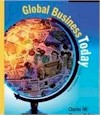 |
 |
| 2nd Edition | 3rd Edition | 4th Edition |
In
a number of international business textbooks an example of rapid changes
in the economic environment
is
the establishing of McDonalds in Moscow after the period of Glasnost and
its effect on the Russian economy.
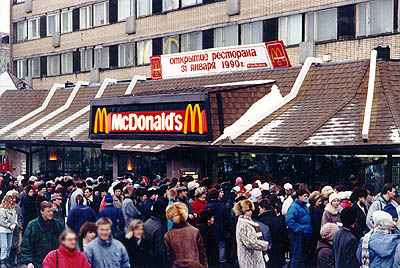
formerlyat www.mcdonalds.com/countries/russia/russia.html McDonald's Pushkin Square restaurant Since opening in 1990, McDonald's now operates 79 restaurants in Russia. |
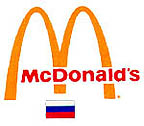
Many people in Toronto know that George A. Cohon, who ran McDonald's in Canada, is the one that opened up McDonald's in Russia and serves as Senior Chairman, McDonald's in Russia.
|
| McDonald's
in Russia
- some opinions 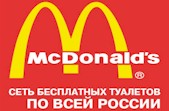 |
In the 4th week of Sept 2005, a student in MGTC44, Victoria Z., commented that Americans like to think that McDonald's in Russia is identified in the public mind with glasnost and perestroika (policies of openness and restructuring) under Mikhail Gorbachev, but Victoria found tons of negative information and some interesting posters and logos, like the one featured to the left. |
| Victoria says
"In fact, Mcdonald's is a symbol of America and capitalism at its worst in the minds of many Russians. When war in Iraq started somebody wrote on the walls of McDonald's in Moscow: "Peace to Iraq, war to McDonalds". |

pic supplied by Victoria |
In some texts there is mention
that nominal exchange rates (rates adjusted for inflation) are not often
a good indicator of the international differences between economies. It
is explained that there is a disparate price of a Big Mac in Russia and
the U.S.A. This difficulty (and the use of comparing Big Macs) became well
known among international business people so it was decided that a serious
discussion could be made using the Big Mac - therefore the origins of the
Hamburger Standard.
.
The
Economist magazine took up the challenge and for several years produced
a chart showing the price of a Big Mac in the countries of the world.
A
simplisitic version of the chart is reproduced below.
http://www.oanda.com/products/bigmac/bigmac.shtml (current listing)
|
|
|
|
|
|
|
|
| United States | $2.43 |
|
| Argentina | Peso 2.50 |
|
| Brazil | Real2.95 |
|
| Britain | £1.90 |
|
| Canada | C$2.99 |
|
| China | Yuan9.90 |
|
| Euro area | €2.52 |
|
| France | FFr17.50 |
|
| Germany | DM 4.95 |
|
| Hong Kong | HK$10.2 |
|
| Indonesia | Rupiah14,500 |
|
| Japan | ¥294 |
|
| Mexico | Peso19.9 |
|
| Russia | Rouble33.50 |
|
| Singapore | s$3.20 |
|
| South Korea | Won3,000 |
|
| Switzerland | SFr5.90 |
|
| Taiwan | NT$70.0 |
|
When
last checked in June 2005, this website www.oanda.comstill
had a version of the chart for viewing
http://www.oanda.com/products/bigmac/bigmac.shtml
(MGTC44 students are provided
this info FYI, you are not expected to be tested on this)

| McDonald's in Hong Kong | In the 2nd week
of Jan 2010, MGTC44 student Wallace C. at UTSC sent an interesting email
talking about his experiences buying a Big Mac in Hong Kong and how he
didn't think the BIG MAC chart was quite accurate.
Wallace explains
I had realized that in 1998-2005 that 1 USD was about 7.80 HKD and in May 2005, something known as the Linked Exchange System Rate was introduced which had 1 USD set at upper and lower limits of $7.75-$7.85 HKD. So if a Big Mac was around $10.2 HKD it would be approximately $1.31 USD. |
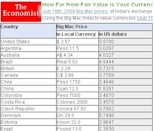 |
Wallace notes the 2009 figures can be seen for the Big Mac, according to 2009 exchange rates, by clicking on the screen capture to the left. |
McDonald's
in Beijing
 |
In the 1st week
of June 2010, MGTC44 student Jonathan S. at UTSC sent an interesting email
talking about his experiences buying a Big Mac in Beijing and how he ALSO
didn't think the BIG MAC chart was quite accurate.
Jonathan's helpful comments but the price of the Chinese Big Mac into the context of wages for the McDonald's employees in China. Jonathan explains
It
is important that people should view the working time-based Big Mac Index
Jonathan
concludes with an interesting observation
WTGR responds I think your analysis Jonathan is very helpful, thanks, and your comments illustrate the different target market segment that some multi-nationals have overseas vs. their home market.. |
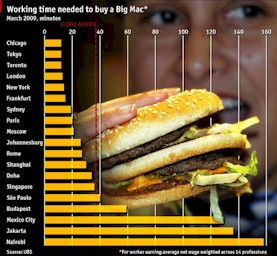
from www.economist.com/node/14288808 data based on European Bank USB |
In Aug 2009, "The Economist"
updated their Big Mac page with the chart shown to the left which illustrates
how many hours a person would have to work to earn a Big Mac in several
cities around the world.
This chart reflects the comparison theme that student Jonathan was talking about it in his June 2010 email. Titled "An alternative
Big Mac index"
|

|
Big Macs
are cheaper in Toronto than New York
"The Economist" chart of
March 2009 is out-of-date for March 2011 in the context of the Canada-US
dollar exchange rate - we have been hovering equal to, or slightly higher
than the US dollar for some time.
|
....

.  |
"The Economist"
magazine does Social Media!
|
cc
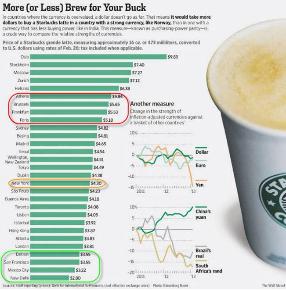 |
In April 2013 student Moosung
Lee in MRK460 at Seneca was part of a group that did a class presentation
about Starbucks.
As part of the presentation they discussed the varying prices of Starbucks products globally. As Starbucks approaches the global brand awareness of McDonald's, it suggests that maybe the BigMac index is not the only fast food brand that can be used to measure the economic environment globally. one source cited for this
graphic is
|
|
|
CONTACT I MAIN PAGE I NEWS GALLERY I E-BIZ SHORTCUTS I INT'L BIZ SHORTCUTS I MKTG&BUSINESS SHORTCUTS I TEACHING SCHEDULE |
| . | |
| MISTAKES ITEXTS USED I IMAGES I RANK IDISCLAIMER I STUDENT CONTRIBUTORS I FORMER STUDENTS IPUBLICATIONS I TIPS I | |
| . |